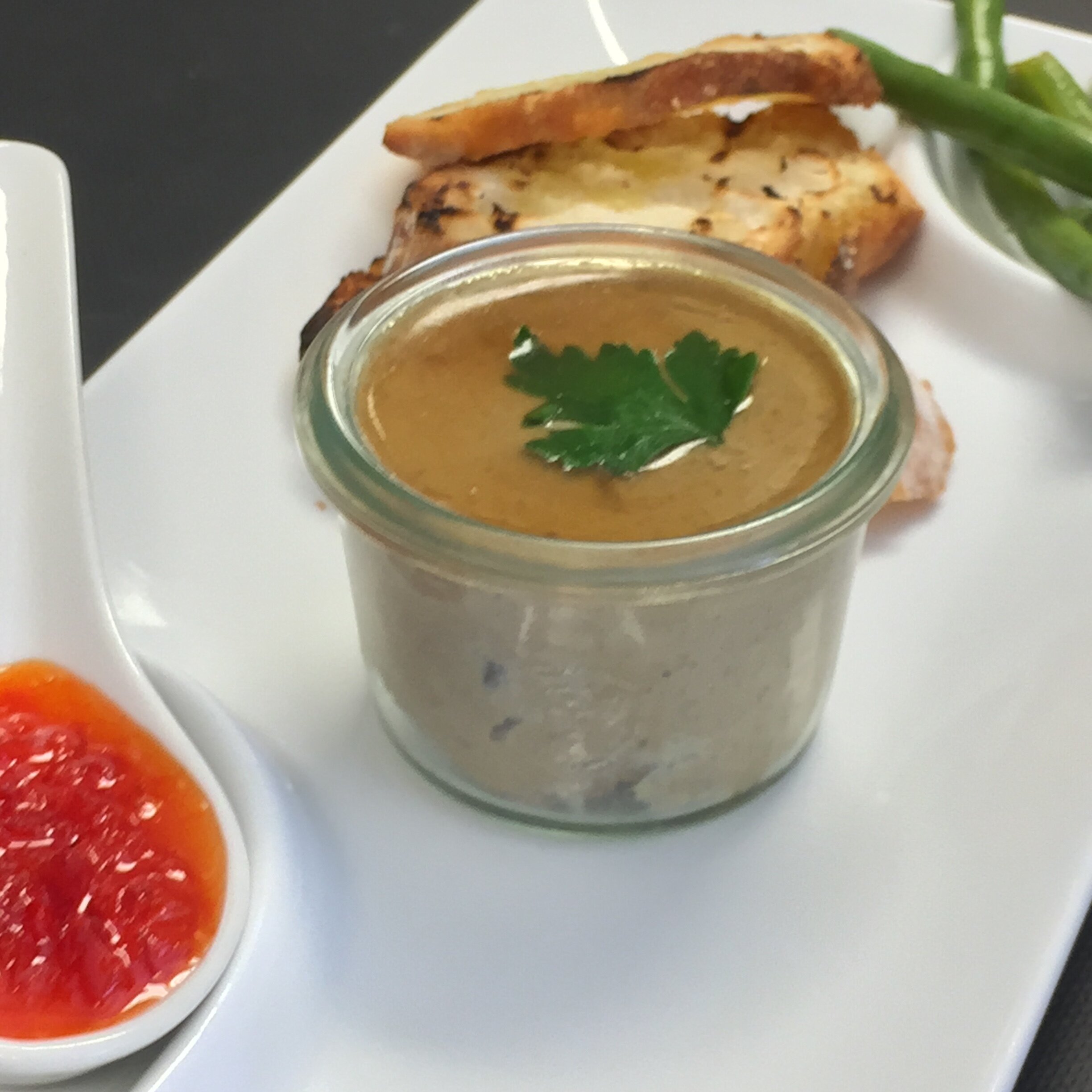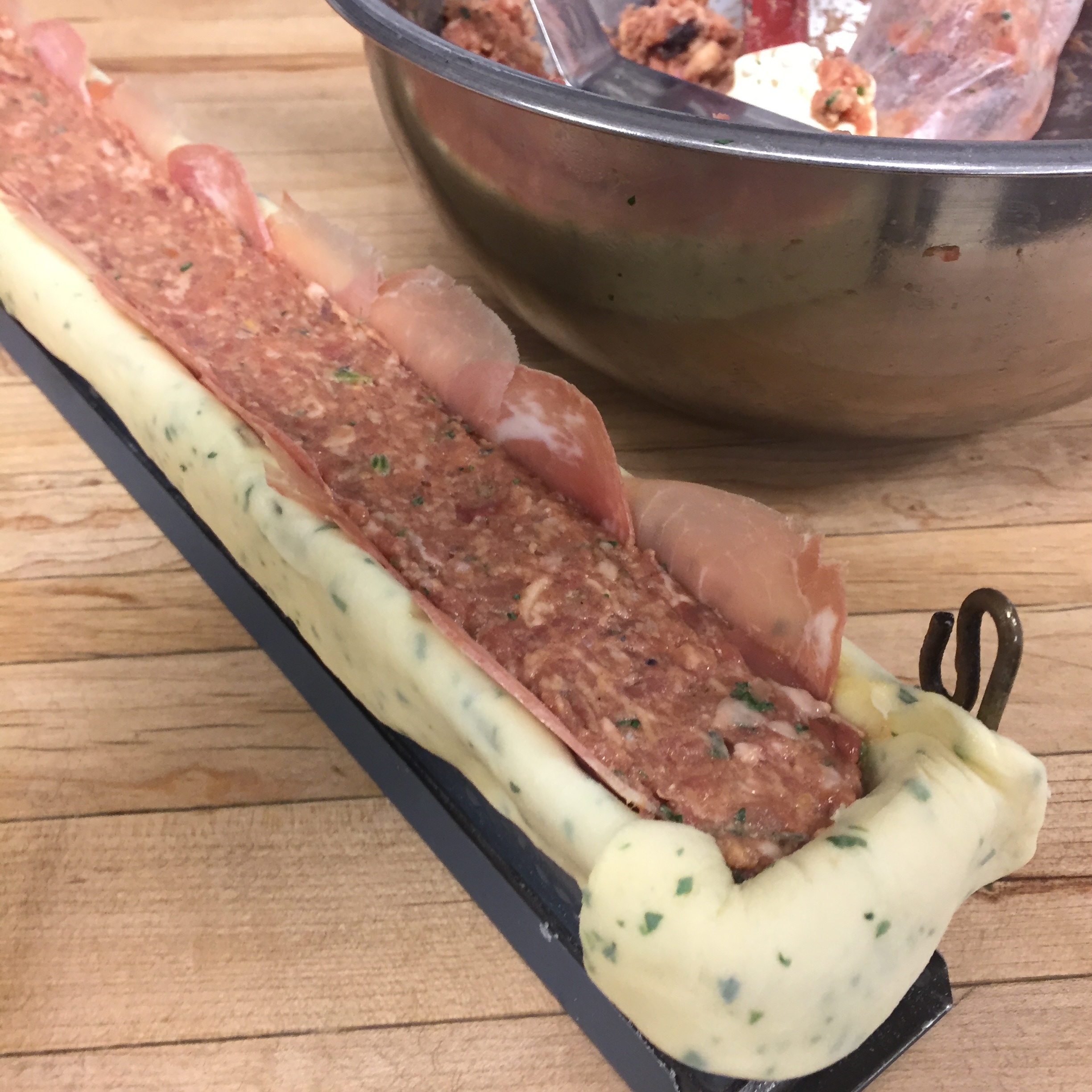Forcemeats
Forcemeats are ground mixtures of meats, poultry, or fish combined with fats, seasoning, and other flavoring ingredients. The mixtures are used in pâtés, terrines, and sausages, as well as fillings for ravioli and wontons, or they can be prepared as quenelles (delicate meat or fish dumplings).
Forcemeat Styles
Gratin Style Forcemeat - Chicken Liver Pâté
There are a few basic styles that are classic to forcemeat preparation including a rustic textured campagne or country-style and a straight forcemeat which is smoother with a more refined texture achieved by the progressive grinding of the ingredients. A gratin forcemeat is created by fully or partially cooking the proteins before processing and is commonly prepared with pork or poultry livers. A Mousseline forcemeat is a light and delicate forcemeat made by emulsifying the ingredients with eggs and cream. A 5/4/3 emulsion forcemeat refers to the ratio of ingredients, 5 parts lean meat, four parts fat, and three parts ice used to make emulsified sausages like bologna and frankfurters.
Forcemeat Ratios
Forcemeats are emulsions produced by combining a certain ratio of lean ground meats and fats. The mixture is sometime bound with eggs, starches, or non-fat dry milk as emulsifiers. Ice is sometimes added for moisture, and to keep the mixture cold. The forcemeat ratio is important for the flavor, structure, and mouth feel of the product. Most ratios use two parts lean meat to one part fat, but ratios vary up to equal parts meat to fat with binding agents used to absorb the extra fat.
Binding Agents
Forcemeats prepared with meats and poultry generally have proteins that are dense enough to hold a proper structure, while those using delicate ingredients, including fish and seafood, may need a little help to create the proper texture and consistency. A thick béchamel sauce, a beurre manie, or other binding agents include egg, aspic gelatin, or nonfat dry milk powder,are incorporated for this purpose. A panada is a paste prepared from flour, bread, rice, or other starch product and used for similar purposes. To maintain the proper taste and texture, use a maximum ratio of 4 parts meat to 1 part binding agents by weight.
Salt and Seasonings
In addition to taste, salt is important for the formation of the emulsion, drawing out moisture and helping the fats and proteins bind together. A ratio of 60 parts meat and fat to 1 part salt (0.3 oz. salt per pound/ 20 g salt per kilo) is recommended. Use curing salt (Prague Powder #1 or Insta Cure #1) at a ratio of ¼ tsp. per 2 lb./1 K of forcemeat as a preservative and for setting the color. Dry curing, brining, or marinating the meat adds flavor, seasoning, and moisture. Use any dry cure, wet brine, or marinade as desired. Marinating with wines and spirits along with aromatic vegetables (shallots and garlic) adds complexity to the forcemeat; allow a minimum of 8-12 hours.
Progressive Grinding
Sieving a Mousseline Forcemeat Through a Tamis
Progressive grinding is used to mix the emulsion evenly, and to produce a smooth refined texture. The product is processed through a grinder 2-3 times starting with a large grind, then to a medium, and finally to a fine grind. Passing the ingredients through a drum sieve, also known as a tamis, removes any excess gristle or sinew that may detract from the smoothness.
Temperature is Crucial
Keep the ingredients as cold as possible to set the emulsion and for sanitation reasons too. Temperatures below 40°F/4°C will keep the fats firm and provide for a smoother texture. If the forcemeat gets too warm the product will take on a loose structure and have a greasy appearance that will affect its overall quality.
Monitor temperatures regularly during the grinding process.
Chill all grinding parts before use.
Partially freeze the meats and fat to keep cold.
Use ice in the emulsion when grinding the forcemeat.
Mixing and Processing
Proper mixing, processing and blending achieve the ultimate structure of the forcemeat and distribute seasonings and flavorings evenly. Mixing can be done by hand but often is done in an electric mixer or a food processor. Care should be taken not to over mix when using a machine. Depending on the amount of product, one to three minutes in an electric mixer at the lowest speed should be sufficient.
Food processors are particularly suited to preparing mousseline forcemeats because the rapid speed can puree the proteins to a fine texture in a short amount of time. Because of the rapid speed of food processor blades, they can create friction and raise the temperature of the product higher than the optimal emulsion temperature of 40°F/4°C.
Testing a Forcemeat
Forcemeats should be tested for taste and texture before assembly and cooking. To test, prepare a quenelle and poach in salted water or stock. Evaluate the seasoning and adjust as needed. For textural correction adjust as follows:
Improve the texture of rubbery forcemeats by the addition of more fat or cream.
A forcemeat that has a loose consistency is firmed by adding egg whites or panada.
Forcemeat Preparation Tips
Straight Forcemeat - Duck Terrine
Keep all surfaces clean and sanitized
Keep all foods cold
Use lean meats trimmed of excess connective tissue
Cure or marinade the meats to add flavor and infuse seasoning
Chill the grinder parts
Partially freeze the ingredients before grinding
Add ice to the meats when grinding to chill the mixture and add moisture to the forcemeat
Use progressive grinding to achieve a fine puree
Sieve forcemeat to remove connective tissue, sinews and gristle
Balance main components with seasoning, aromatics and wine or spirits that will accent and highlight the natural flavors
Since forcemeats are commonly presented as cold pates, terrines and galantines should always be seasoned up




